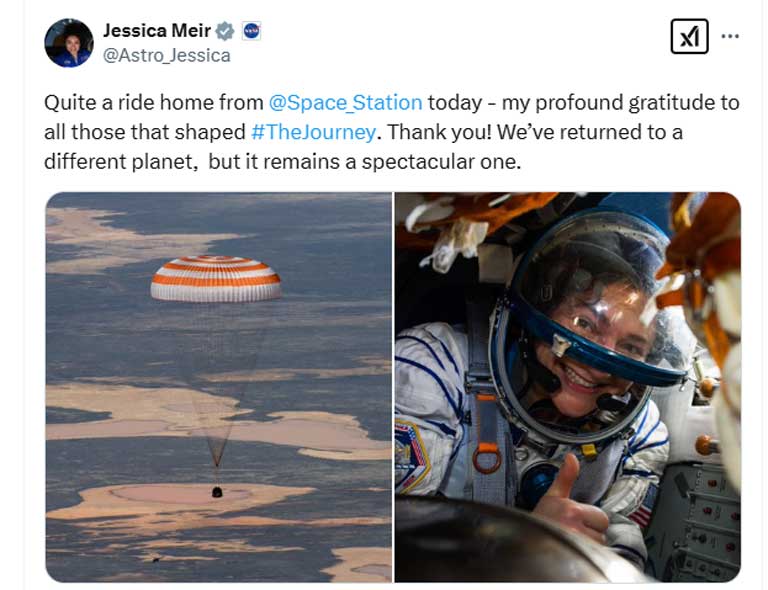Returning Home for Earth Day: NASA Astronauts Jessica Meir and Andrew Morgan Conclude Their Successful Mission on the ISS

NASA astronauts and Expedition 62 Flight Engineers Andrew Morgan and Jessica Meir are pictured inside the cupola, the International Space Station's "window to the world," shortly after capturing the SpaceX Dragon resupply ship.
Media Credit: NASA
April 21, 2020
After spending many months viewing our planet from space, NASANational Aeronautics and Space Administration astronauts Jessica Meir and Andrew Morgan returned home this weekend just in time to celebrate the 50th anniversary of Earth Day back on the ground.

Meir and Morgan viewed Earth from many angles during their mission—including the view from outside the International Space Station (ISSInternational Space Station)! During her 205 days on the ISS, Meir orbited the Earth 3,280 times and conducted the first three all-woman spacewalks with NASA astronaut Christina Koch. Morgan had an extended stay of 272 days in space, completing 4,352 Earth orbits. During some of his seven spacewalks, he performed repairs to the Alpha Magnetic Spectrometer, a particle-physics detector that looks out into space to advance critical knowledge for use on Earth!
While onboard the space station, Meir and Morgan worked on research to further our nation’s goals toward landing the first woman and next man on the moon and ultimately on Mars—but they also worked on many research projects sponsored by the ISS U.S. National Laboratory, all aimed at benefiting our home planet and the quality of life for those on Earth!
Bone and Muscle Health
Without the exercises and countermeasures taken by astronauts, microgravityThe condition of perceived weightlessness created when an object is in free fall, for example when an object is in orbital motion. Microgravity alters many observable phenomena within the physical and life sciences, allowing scientists to study things in ways not possible on Earth. The International Space Station provides access to a persistent microgravity environment. causes rapid muscle and bone loss. Scientists use this accelerated deterioration to model diseases in space, in order to improve treatments for patients on Earth.
For example, Meir worked on The Jackson Laboratory’s “Mighty Mouse” investigation, which used mice in space to model Earth-based diseases that cause muscle and bone loss. Both Meir and Morgan also worked on a project from the University of Minnesota, sponsored by the National Institutes of Health, aimed at improving the way scientists grow human cells to study diseases like osteoporosis.
Heart Health and Regenerative Medicine
In the area of heart health, Meir and Morgan worked on a project from Emory University that produced specialized heart muscle cells, using adult human cells altered to behave like stem cells. The team’s prior ground-based research using simulated microgravity was highly successful, and true microgravity on the ISS is expected to produce even more high-quality cells, ultimately for use in studying and treating heart disease on Earth.
Morgan also worked on Techshot’s BioFabrication Facility (BFF(Abbreviation: BFF) The BFF is a 3D bioprinter on the ISS capable of printing human tissue from bioinks mixed with living cells. This ISS National Lab commercial facility is owned and operated by Redwire Space.)—the first U.S. bioprinter on the ISS. The BFF’s initial test prints used human heart cells, and Techshot also recently produced test prints of a partial human meniscus (knee cartilage). Bioprinting in microgravity might not need scaffolding to support printed tissues, which is currently a hurdle in Earth-based bioprinting, for example in combatting the organ shortage crisis.
Other Biomedical Research
While in orbit, Morgan worked on an experiment from the biotechnology startup MicroQuin to study how well a potential cancer treatment binds to a protein involved in tumor development. Meir and Morgan also worked on a rodent research experiment from Baylor College of Medicine exploring new ways to treat metabolic disorders such as liver disease, diabetes, and other illnesses associated with obesity.
Learn more about Meir and Morgan’s time on the ISS and the wide variety of research the pair contributed to in this NASA article.